Now & New
Hanamichi Onomichi, Part One: Sakura on the Temple Walk
When it comes to hot hanami spots in Japan, especially those within Hiroshima Prefecture, Onomichi’s Senkoji Park takes the cake and eats it too. The park has unsurprisingly earned its place on the 100 Famous Sakura Sites in Japan, and thus, has become a prime tourist destination during sakura season, and oft-frequented by residents of Hiroshima Prefecture in every season. In addition to Senkoji, visitors to Onomichi typically like to check out the myriad temples in the city; coincidentally, these sites are also where most cherry trees in mainland Onomichi can be found.
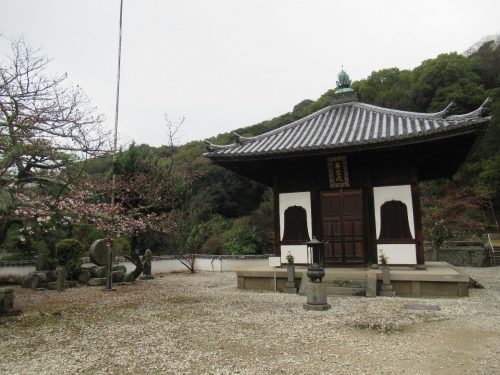
The temples in the cozy town of Onomichi are seemingly without number, and only a minority of all tourists actually visit all the temples on the Temple Walk. I myself could only care to hit up the seven principal temples scattered across the city, but thankfully, they aren’t too far apart from each other, and one can get to all seven of them following a pretty straightforward path with minimal diversions. As I was planning on seeing sakura all over Onomichi (and beyond), I made an effort to get up early to tackle the temples as soon as I could. To that end, I aimed to get on a certain Shinkansen, the Kodama 838, which departs from Hiroshima Station at 8:17 in the morning. However, it wasn’t just the early start that made this the ideal mode of transport.
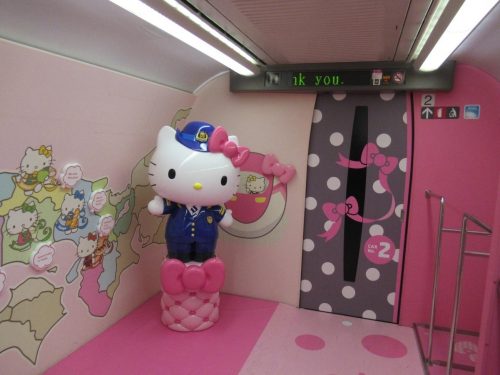
The Hello Kitty Shinkansen runs from Hakata Station to Shin-Osaka Station in the morning, and from Shin-Osaka back to Hakata in the afternoon, stopping at the same stations where a regular Kodama Shinkansen would call. A ticket for this train doesn’t cost a single yen more (reserved or non-reserved) than it would for any other Shinkansen, but you may want to reserve seats if traveling in a sizable group during high seasons. The entire interior is pink and covered in Hello Kitty imagery, but Cars #1 and #2 have the most interesting décor, and no matter where on the train you sit, most passengers will make their way to those cars for tons of adorable photo opportunities! This statue in Car #2 of Hello Kitty dressed like the train crew is where many families stop to pose for pictures, and the wall besides the statue details the stereotypical food of every prefecture between Fukuoka and Osaka Prefectures.
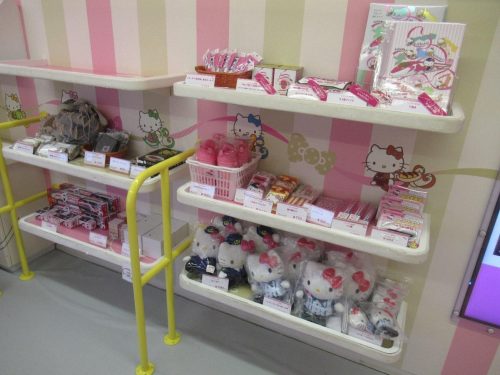
Over in Car #1 is the gift shop, which features even more pictures of Hello Kitty promoting sites in different prefectures, and even a mini-theater advertising Kobe as a tourist destination. I was so caught up in taking the perfect photos and learning about other noteworthy sites in Japan that by the time I was pondering over the souvenirs, the Shinkansen was fast approaching Shin-Onomichi Station. With only minutes to spare, I treated myself to a tin of candy drops and got ready to disembark.
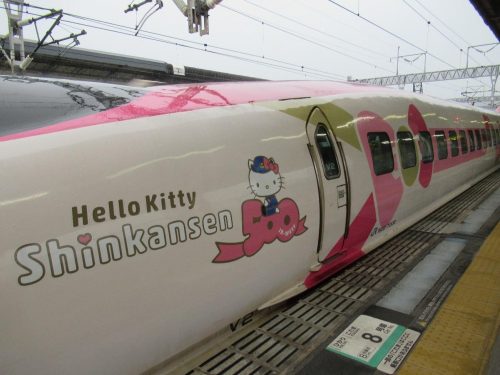
持光寺 (Jikoji)
As the vessel shut its doors and left me behind, I exited Shin-Onomichi Station and entered some pretty ugly weather. I actually knew it was going to rain today, but considering that this final weekend in March was the optimal time in my schedule to travel, and that rainy weather tends to clear up in the middle of my trip (I have that kind of adventurer’s luck), I packed a waterproof jacket and an umbrella beforehand and hoped for the best. It wasn’t long before a bus came by the station to pick me up and take me to Onomichi Station (where normal JR trains stop), from whence I would begin my trek in earnest. Shortly after entering Onomichi Hondori, I swung a left up some stairs, crossed the street and some railroad tracks, climbed up even more steps, and got to the first site of my Temple Walk: Jikoji.

If it wasn’t hard enough to hold my camera and umbrella steadily at the same time while exploring the temple grounds, it was still pouring, which impacted the quality of my pictures that morning. Any cherry trees to be found at Jikoji only had buds on them, so there wasn’t much pink to brighten up things either. What sets Jikoji apart from the other primary temples in Onomichi is the “nigiri Buddha” experience, wherein participants take a wad of clay, squeeze it tightly in one hand until it takes on a doll shape, then set it down, draw a face on the head, and have it fired into a lucky statuette. I inquired about the experience with the monk there, but after realizing I didn’t have the time and money to take part today, I politely declined and made my way back to Onomichi Hondori for some cover from the rain. Hopefully, there would be more cherry blossoms and less rain by the time I reached the second temple.

天寧寺と千光寺 (Tenneiji and Senkoji)
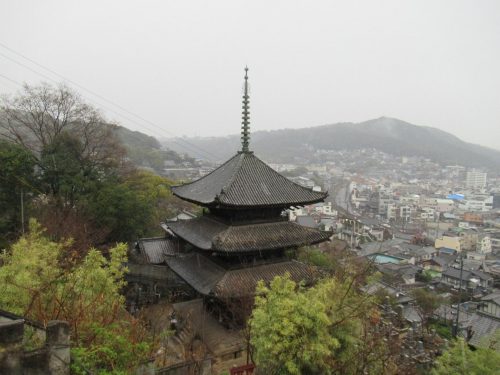
When I came upon a crêperie called “Eternity” that had yet to open, I hung a left again back into the rain, and headed up the incline to the second temple, Tenneiji. The one thing everyone comes here to photograph is the pagoda, which I’ve captured on camera several times before, but surprise, surprise: it’s not so flattering when skies are gray! To add insult to injury, the cherry trees behind me weren’t ready yet either, leaving nothing to look at save for a cat that popped out from behind a stone monument.
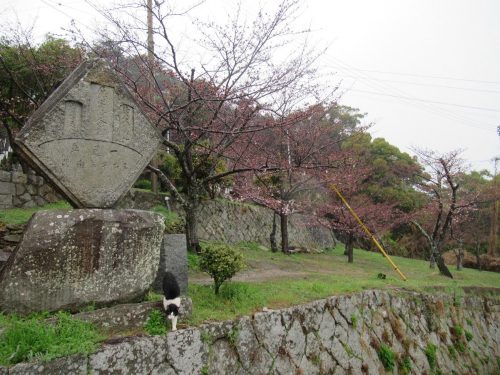
With the second temple out of the way, I turned left onto a staircase leading to Senkoji, Onomichi’s most iconic temple. Even from the bottom of the stairs, I was starting to have a little more hope as the number of open flowers on each tree was increasing, but it still wasn’t anything to write home about. The temple grounds of Senkoji–which are usually brimming with visitors on a Saturday–were mostly devoid of people. If there’s anything to pray for at this point, it would be for the sun to come out of hiding, but I guess those wiser than me were probably doing that from home, nice and dry.

The sakura situation only started to get interesting near the observatory at the top of the hill. As of March 26th, the newly-refurbished observatory still wasn’t open, so I wasn’t allowed to get close to the pinkest trees I had seen thus far. On the other hand, I was able to take the Senkoji ropeway back down to street level for only \310 one way before the price would jump up to \500 in April. Two ladies in overcoats accompanied me and one other passenger on this dreary morning, and gave commentary on what we could see out the windows. It was also at this point that the rain began to subside, which meant my trip was on its way up as I was on my way down.
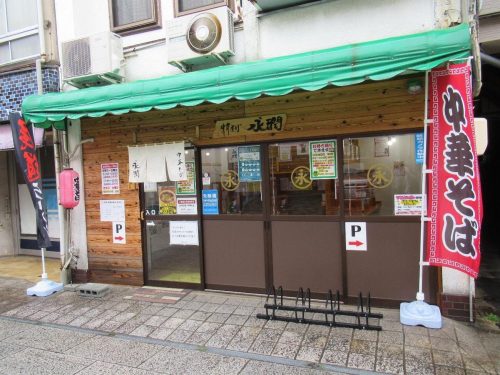
I didn’t have a big breakfast, so by 11:00 I was already itching for lunch. After searching on my smartphone for nearby ramen joints, I discovered 永潤 (えいじゅん – Eijun), a reputable store that was on the way to the next temples. I got there a bit early and waited for the clock to strike eleven before entering the doors as their first customer of the day. Guests order from a ticket vending machine before giving their order to the staff and being seated at one of the individual booths. There are shelves above the dining table where diners can place their things, and water, utensils, and seasoning were all self-serve, strategically placed inside every single booth. When my ramen was done, the server called out to me and opened the blinds to give me my food.
There are blank stamp cards available at the booths, so I had placed one in the appropriate space before my food came. The server took my blank one and replaced it with a card with one stamp, then closed the blinds, leaving me to eat in peace. Both the noodles and the broth in which they pooled were rich in taste, with enough fat and saltiness to make me thankful to have the water pitcher by my side. The soup and water combined filled me up to where I didn’t need a second helping of noodles, so I took my things and continued on my way. In addition to the private booth style that isn’t so common these days, having a stamp card is also a great incentive for me to return next time I come to Onomichi.
大山寺と西國寺 (Taisanji and Saikokuji)
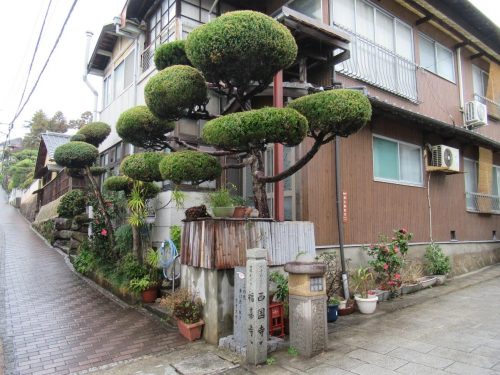
Back outside, I continued along the street and turned left at a Poplar convenience store, crossed the street, passed under the railroad tracks, and came to a fork in the road. The path to the left leads to Taisanji and the road to the right takes one to Saikokuji, both being principal sites on the Temple Walk. It doesn’t matter which one you take since both temples are connected, but I went left because the colored-brick road was more inviting.
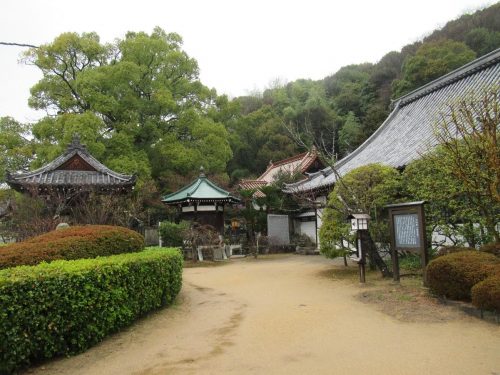
It was a bit of a climb up that seemingly harmless brick road, but I finally made it to Taisanji. There wasn’t much as far as sakura were concerned, but the architecture made it a worthy visit. Besides that, by the main sign was an audio guide that provided an explanation on the temple in Japanese, English, Korean, Mandarin, and Cantonese.
I turned right and progressed to the main office of the temple, where I found a most amusing statue. It was the polar opposite of the three wise monkeys in Nikko that “see no evil, speak no evil, and hear no evil,” in that these three monkeys in Onomichi try hard to see, speak, and hear. The plaque beside them reads,
“They are seeing. They are speaking. They are listening. They are forward-looking monkeys.”
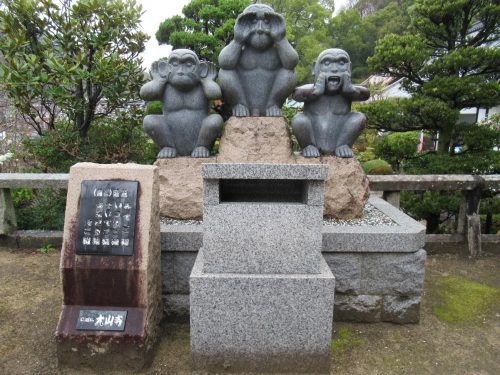
Perhaps it’s a message to look for, listen for, and say good things, or maybe it’s encouraging folks not to turn a blind eye to injustices in the world. Whatever your interpretation is, this statue alone warrants a visit to Taisanji if you swing by Onomichi. From here, it was a short walk to Saikokuji.
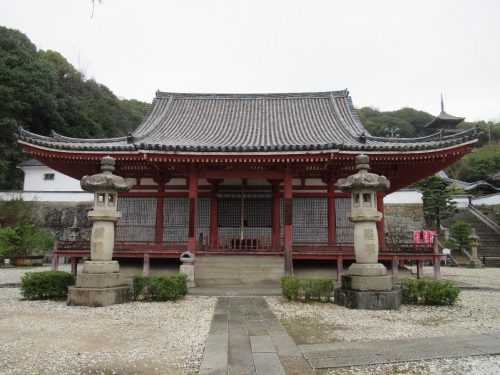
The grounds of Saikokuji were more spacious, so there were more buildings around, and also more cherry trees. Indeed, the sakura didn’t get good until the fifth temple I visited, but so long as one site yielded beautiful, pink blossoms, I considered my outing successful. Having dry skies also made photography of the sakura a lot easier.
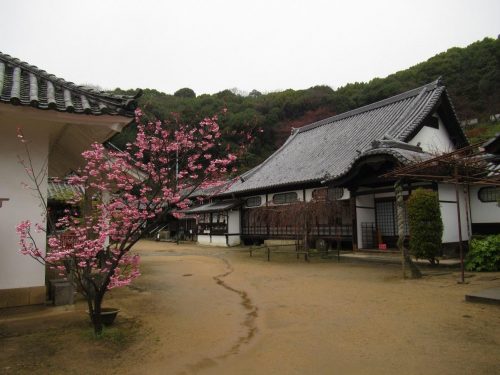
Moment of Joy: After the Rain
This was the first clear photo I could take of the cherry blossoms up close because the rain kept getting in the way before. What’s more, the lingering raindrops on the flowers accented their beauty, leaving a photo I can treasure more than one taken on a sunny day. Out of all the cherry trees I would see across seven temples that day, these blossoms on the grounds of Saikokuji were the best. It was at this moment that I finally felt a sense of accomplishment, and was able to hit up the last two temples in higher spirits.
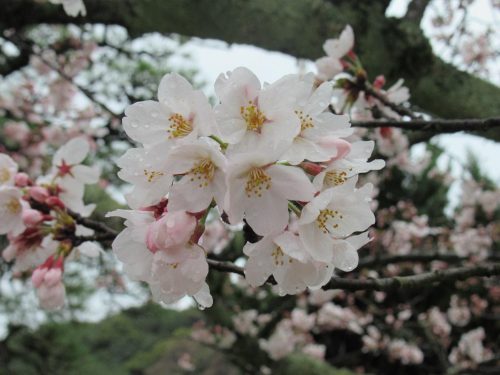
浄土寺と海龍寺 (Jodoji and Kairyuji)
I made my way down the hill and back to the main street where I stopped for ramen, then continued east. When the street gave way to a busy intersection, I crossed two crosswalks and walked toward Onomichi Central Library, where I turned right and kept going until reaching Jodoji on my left. There weren’t as many open cherry blossoms here as there were at Saikokuji, but there were white tents set up, making me wonder if there was an event here today.
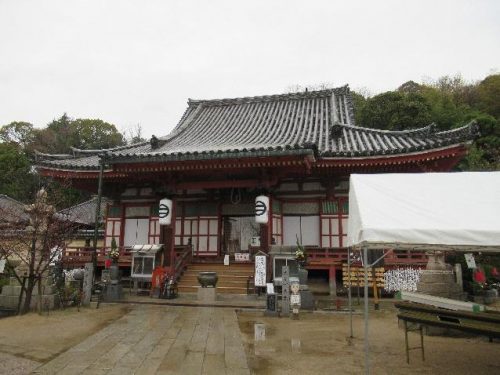
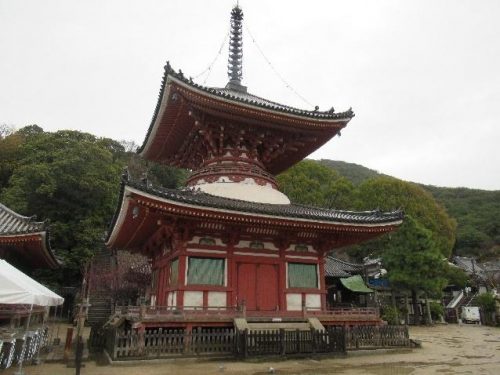
Despite the rain having stopped, the ground was still muddled with puddles, so I had to tread carefully when walking toward the Tahoto pagoda in the direction of Kairyuji, the final temple on my journey.
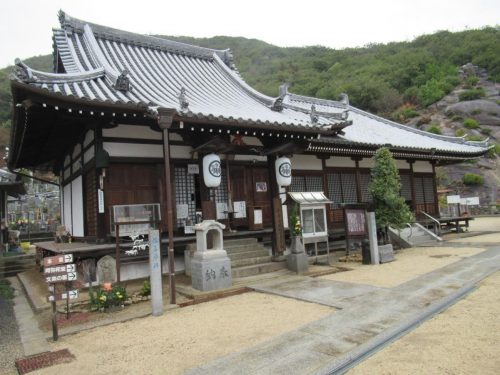
Kairyuji isn’t that flashy of a temple: you’ve got the main hall, a cemetery in the back, and a tiny garden with other minor buildings to the side. Yet, this tiny garden is where Kairyuji shines, as it had some cherry blossoms that had fully bloomed, even to the point where they were being replaced by green leaves. I found it most peculiar that different temples in the same city would have sakura at different stages of their lives, but I took that as a reflection of how every temple in Onomichi was at a different stage of development at the same time, just like how humans and other living things grow and develop at different rates. Like Taisanji, Kairyuji also has a quinquelingual audio guide, so I have that a listen in all five languages before moseying back to Onomichi Station where I started.
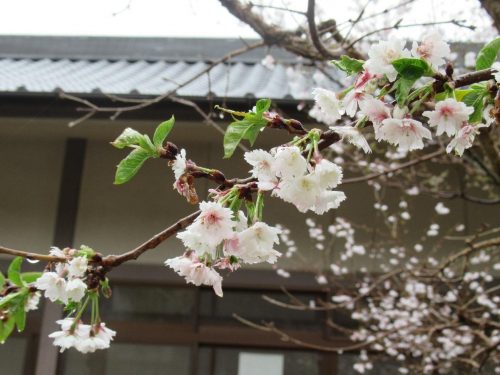
Overall, late March seemed to be premature for a trip to Onomichi in terms of sakura, but I guess only a trip there would’ve taught me that. In spite of that, though, this time of year is optimal temperature-wise to do the Temple Walk (when it’s not raining), so no worries if you can’t make it here during peak season. However, a hardcore adventurer such as myself wasn’t satisfied with only the few ripe sakura encountered today, so my next course of action was to check out the islands off the coast of mainland Onomichi. I would need a bicycle to get around on insular Onomichi, but I already had a plan in mind.
To be continued…
Written by the Joy in HIROSHIMA Official Team
